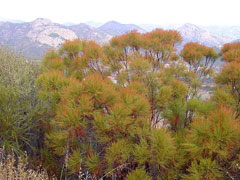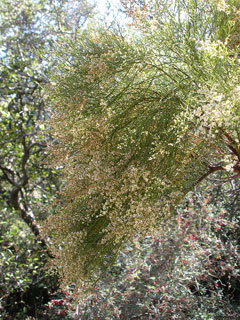 |
|
http://commons.wikimedia.org/wiki/User:NoahElhardt |
 |
| http://www.flickr.com/photos/57453294@N00/2805426598/ |
Translate this page:
Summary
Physical Characteristics

 Adenostoma sparsifolium is an evergreen Shrub growing to 6 m (19ft 8in).
Adenostoma sparsifolium is an evergreen Shrub growing to 6 m (19ft 8in).
See above for USDA hardiness. It is hardy to UK zone 8. It is in leaf all year, in flower from May to June. The species is hermaphrodite (has both male and female organs) and is pollinated by Insects.
Suitable for: light (sandy), medium (loamy) and heavy (clay) soils, prefers well-drained soil and can grow in nutritionally poor soil. Suitable pH: mildly acid, neutral and basic (mildly alkaline) soils. It cannot grow in the shade. It prefers dry or moist soil and can tolerate drought.
UK Hardiness Map
US Hardiness Map
Synonyms
Plant Habitats
Cultivated Beds;
Edible Uses
Seeds[257]. No further information is given.
References More on Edible Uses
Medicinal Uses
Plants For A Future can not take any responsibility for any adverse effects from the use of plants. Always seek advice from a professional before using a plant medicinally.
The plant is cathartic[257]. The plant has been used externally in the treatment of arthritis[257]. An infusion of the leaves has been used in the treatment of colds and chest complaints, and also as a mouth wash to treat toothaches[257]. An infusion of the dried leaves, or the branches, has been used in the treatment of stomach ailments, inducing either bowel movements or vomiting[257]. The crushed twigs have been mixed with oil and used as a salve[257].
References More on Medicinal Uses
The Bookshop: Edible Plant Books
Our Latest books on Perennial Plants For Food Forests and Permaculture Gardens in paperback or digital formats.

Edible Tropical Plants
Food Forest Plants for Hotter Conditions: 250+ Plants For Tropical Food Forests & Permaculture Gardens.
More

Edible Temperate Plants
Plants for Your Food Forest: 500 Plants for Temperate Food Forests & Permaculture Gardens.
More

More Books
PFAF have eight books available in paperback and digital formats. Browse the shop for more information.
Shop Now
Other Uses
The bark is fibrous and has been stripped off the plants to make women's skirts[257]. The wood has been used to make fencing posts and as construction material[257]. The wood burns well, giving a high intensity heat[257].
Special Uses
Scented Plants
References More on Other Uses
Cultivation details
Requires a sheltered sunny position in a well-drained soil[182, 200] and protection from cold winds[200]. Plants are not very hardy in Britain and do not withstand exposure to prolonged winter frosts though they succeed outdoors in the milder areas of the country[182, 200]. In colder areas they are best grown against a south or south-west facing wall[200]. The leaves are resinous and catch fire easily[181]. They have a pleasant aroma[200].
References Carbon Farming Information and Carbon Sequestration Information
Temperature Converter
Type a value in the Celsius field to convert the value to Fahrenheit:
Fahrenheit:
The PFAF Bookshop
Plants For A Future have a number of books available in paperback and digital form. Book titles include Edible Plants, Edible Perennials, Edible Trees,Edible Shrubs, Woodland Gardening, and Temperate Food Forest Plants. Our new book is Food Forest Plants For Hotter Conditions (Tropical and Sub-Tropical).
Shop Now
Plant Propagation
Seed - we have no information for this species but suggest sowing the seed in a greenhouse in early spring. When large enough to handle, prick the seedlings out into individual pots and grow the plants on for at least their first winter in a greenhouse or cold frame, planting them out in late spring or early summer, after the last expected frosts. Cuttings could be tried in August of half-ripe wood, preferably with a heel, in a frame. Layering.
Other Names
If available other names are mentioned here
Native Range
NORTHERN AMERICA: United States (California), Mexico (Baja)
Weed Potential
Right plant wrong place. We are currently updating this section.
Please note that a plant may be invasive in one area but may not in your area so it's worth checking.
Conservation Status
IUCN Red List of Threatened Plants Status :

Growth: S = slow M = medium F = fast. Soil: L = light (sandy) M = medium H = heavy (clay). pH: A = acid N = neutral B = basic (alkaline). Shade: F = full shade S = semi-shade N = no shade. Moisture: D = dry M = Moist We = wet Wa = water.
Now available:
Food Forest Plants for Mediterranean Conditions
350+ Perennial Plants For Mediterranean and Drier Food Forests and Permaculture Gardens.
[Paperback and eBook]
This is the third in Plants For A Future's series of plant guides for food forests tailored to
specific climate zones. Following volumes on temperate and tropical ecosystems, this book focuses
on species suited to Mediterranean conditions—regions with hot, dry summers and cool, wet winters,
often facing the added challenge of climate change.
Read More
Expert comment
Author
Torr.
Botanical References
200
Links / References
For a list of references used on this page please go here
Readers comment
© 2010, Plants For A Future. Plants For A Future is a charitable company limited by guarantee, registered in England and Wales. Charity No. 1057719, Company No. 3204567.